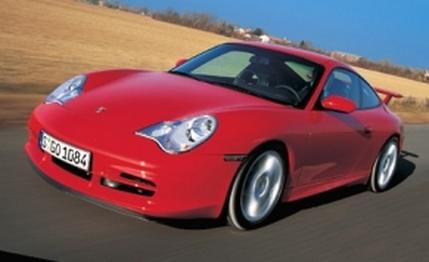 First Drive Review
First Drive Review
With a spring arrival of the 2004 Porsche 911 GT3—and the introduction of the outrageous Carrera GT supercar later this year (see page 68)—Porsche is reasserting its position as a premier sports-car builder. Could this year's offerings be penance for its Cayenne sport-ute?
Maybe not, but the GT3 is a 911 to brag about, a naturally aspirated, 375-hp version of the $183,765 twin-turbocharged, 456-hp Porsche 911 GT2. It will sell for about $84,000 less than the GT2—figure an even $100,000—and will fill the rather wide performance and price gap that existed between the $82,565 911 Carrera 4S and the $118,265 911 Turbo. Now there's a vast array of 911 models, from the base $69,365 Carrera to the extravagant GT2.
The GT2 was and is Porsche's response to those who suggest that the 911 Turbo is a soulless high-speed appliance. On Porsche's scales the GT2 weighs about 220 pounds less than the Turbo because it doesn't have the Turbo's four-wheel-drive system. It also makes more horsepower (456 versus 415).
Likewise, the GT3 is the hairiest of the non-turbo 911s. It packs 60 more horsepower—for a total of 375—and, no surprise, has a suspension tuned more for racetrack driving dynamics than on-road comfort. It's also the first GT3 street car offered in the U.S.
The previous Porsche GT3, introduced at the Geneva show in 1999, wasn't sold in the U.S. Its intended mission: Satisfy the homologation rule required to race in the Le Mans GT class that says an automaker must sell at least 500 production versions of the car it is going to race. So Porsche cooked up a higher-performance 911 and called it the GT3. Porsche easily met the 500-car minimum and in fact built 1856 of them.
There wasn't a homologation requirement to fulfill this year, so the GT3 is simply another model in the 911 range. The main difference between the GT3 and lesser 911s is the engine. Standard 911s use a two-piece engine block split down the center line of the crankcase. On the GT3, Turbo, and GT2 models, the split-crankcase parts are cast separately and bolted to the two blocks of three cylinders per bank, a design that was originally developed specifically for racing applications.
The benefit of this design is that it's stiffer and can accommodate higher power levels. The removable cylinders, Porsche says, also allow for easy displacement modifications to accommodate ever-changing racing rules. The GT3 shares its 3600cc displacement with the 911 Turbo and GT2 (regular 911s are 4cc smaller, derived from a smaller bore and longer stroke).
The GT3 is the highest-revving of any 911 because it has the lightest engine internals. The redline on the tachometer is 8200 rpm for the GT3, 7300 for a base Carrera, and 6750 for the Turbo and GT2. Compared with the 911 Carrera, the GT3 uses titanium connecting rods that are 0.09 inch longer, shorter pistons, and shorter hydraulic valve tappets. Porsche says that by using the lighter pieces, it could also remove the crankshaft vibration damper, saving 4.4 pounds.
Even though Porsche included its variable-valve-timing system to smooth out the power band, the 375-hp power peak occurs high in the rev range—at 7400 rpm—and the torque peak of 284 pound-feet is at 5000 rpm.